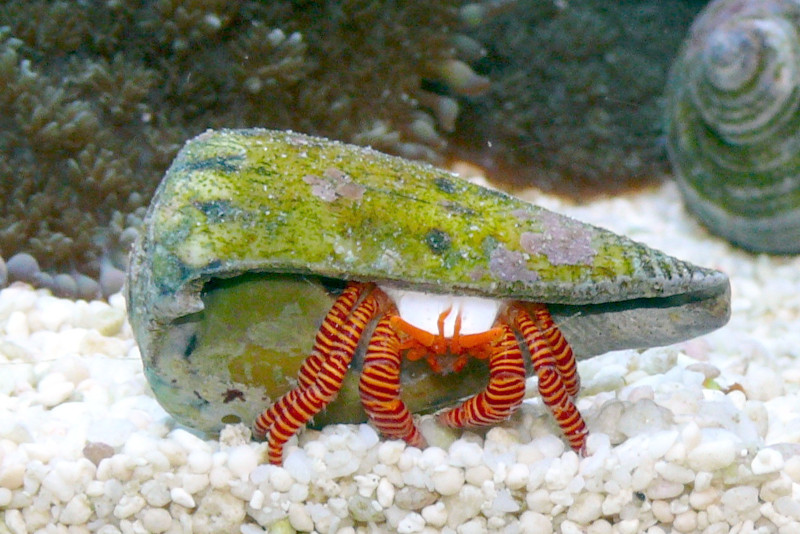
Halloween Hermit Crab Facts
- The attention-grabbing term of Halloween Hermit Crab serves as the most frequently used common name for this natural wonder. It does have another, less often used title, though. That’s the less showy but descriptive term of the striped hermit crab.
- Inside of scientific circles, however, it’s typically better known by its official title. Unfortunately, that’s an extremely difficult moniker for the layperson to pronounce. That’s because it bears the tongue-twisting technical name of the Ciliopagurus strigatus.
- The remarkable Arthropod received that hard to say title due to the efforts of the German naturalist, Johann Friedrich Wilhelm Herbst. He recorded the first recognition of it as a separate and dsitinct species. That noteworthy deed occurred in 1804.
- Thankfully, the unusual Halloween Hermit Crab seems to be maintaining a population base that’s sizeable and relatively stable. That fortunate state also appears to hold true throughout the entirety of its range. The IUCN thus has no Red List status for it.
- The species nevertheless does face some potential threats to its continued existence in the wild, at least. Most of these stem from the actions of humans. They include the common perils of habitat dedragation and loss, as well as climate change, of course.
Related Articles
Halloween Hermit Crab Physical Description
The magnificent Halloween Hermit Crab clearly merits its appreciation due to its appearance. This serves as ample proof that Nature places no importance on physical size. That holds true due to the fact that this marvel of evolution remain quite small in stature.
It additionally adheres to the pattern of growth typical to its many related species. That’s the fact that it displays a certain degree of the phyiological characteristic of sexual dimorphism. In the case of this crustacean, that trait manifests itself in terms of simple size.
More precisely, males attain greater average measurements than their female counterparts. The gender-based differences remain small, however. It’s therefore often difficult for the untrained expert to distinguish the sexes based on simple visual observation.
Overall, though, individuals of this interesting species reach a mature body length equaling about 2 in (5 cm). Though small compared to many crustaceans, it’s actually relatively large among hermit crabs. Including the shell, it rarely weighs more than 1 lb (0.5 kg).
The gorgeous Halloween Hermit Crab also boasts some other appealing qualities, as well. Its body manifests a clearly flattened, shield. This structure averages about 0.32 in (0.8 cm) in length. Uniquely, this aspect of its body also typically presents a bright white color.
It’s the rest of the body, combined with this, that earns the creature its name, though. Its eye stalks show a vibrant orange hue. The body presents a deep red shade, while the legs display a bright orange color, with horizontal white stripes. That’s truly a remarkable look!
- Kingdom: Animalia
- Phylum: Arthropoda
- Class: Malacostraca
- Order: Decapoda
- Family: Diogenidae
- Genus: Ciliopagaurus
- Species: C. strigatus
Halloween Hermit Crab Distribution, Habitat, and Ecology
The aptly-named Halloween Hermit Crab evolved as native to a moderately wide expanse of the marine waters of the world. The exact parameters of that range likely won’t surprise many people. That’s true since it developed as endemic to most of the Indo-Pacific.
Within that greater zone of habitation, though, its population appears more commonly in certain areas. That’s not uncommon among its kindred. A few of the smaller areas in which it makes its home include the waters around Hawaii, and even parts of the Red Sea.
The visually impressive work of Nature also displays strong preferences in its choice of habitat. Broadly speaking, it lives almost exclusively along regions of coral substrate. This most frequently consists of areas of the sandy regions surrounding coral reefs, not on them.
Yet its specific requirements for where the crustacean lives do not stop there. The creature also strongly prefers very shallow regions of the ocean. These typically consist of tropical, coastal areas. In point of fact, it’s rarely seen at depths greater than 50 ft (15.2 m).
Again following patterns similar to its relatives, the Halloween Hermit Crab typically lives a strong social life. Due to this tendency, the vast majority of mature specimens in the wild live usually in large groups. These sometimes number as many as 100 individuals.
It evolved as nocturnal in nature, and that’s when the animal does most of its hunting. It feeds as an omnivore, and a scavenger, as well. It also consumes almost anything it finds of a suitable size. That menu list includes such items as detritus, live prey, and algae.
Species Sharing Its Range
Check out our other articles on 3 Surprising Sahara Desert Sites, European Honey Buzzard, Cheddar Gorge, Blue Orchard Bee, Mangrove Monitor, Eastern Gray Squirrel, Bonnethead Shark
